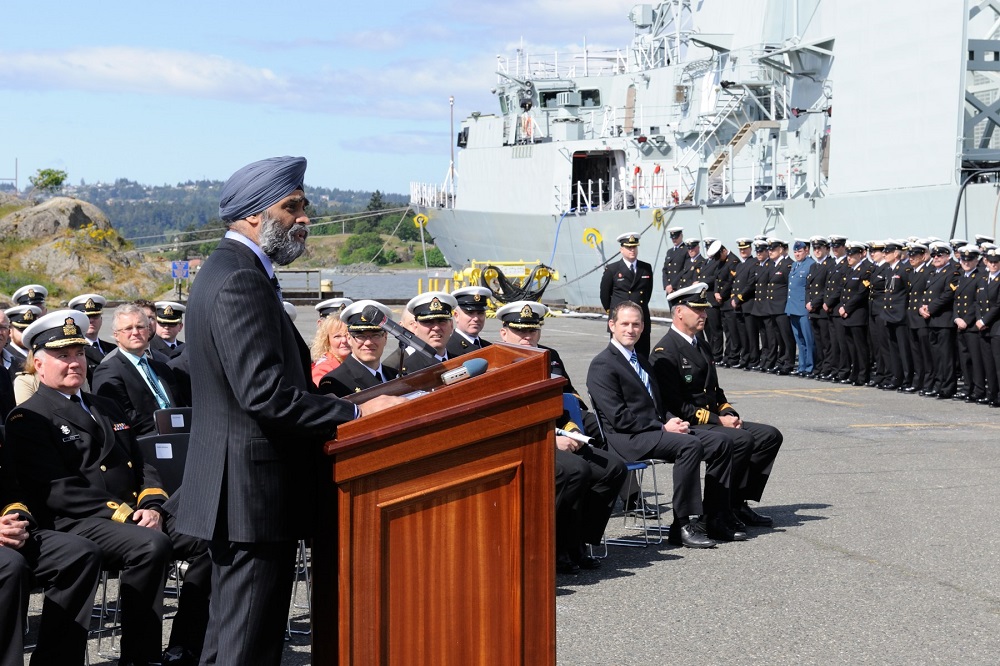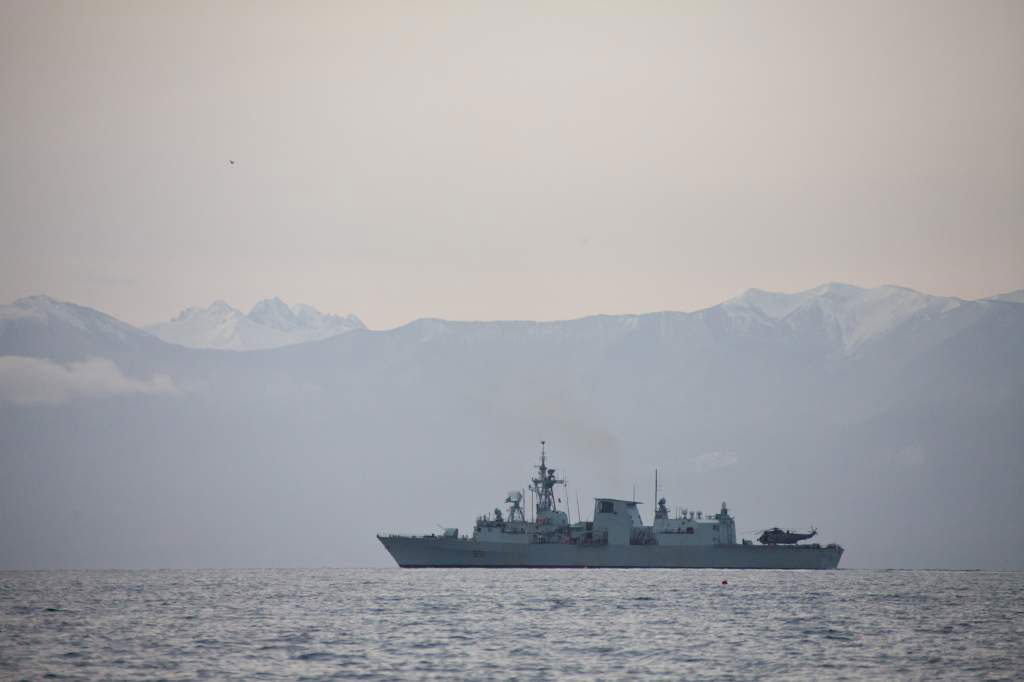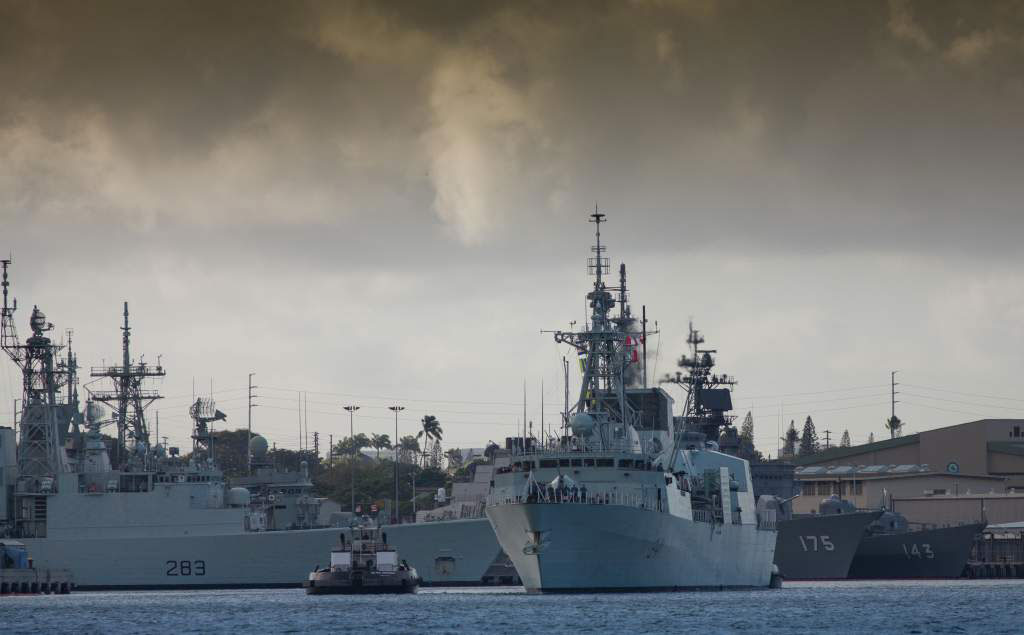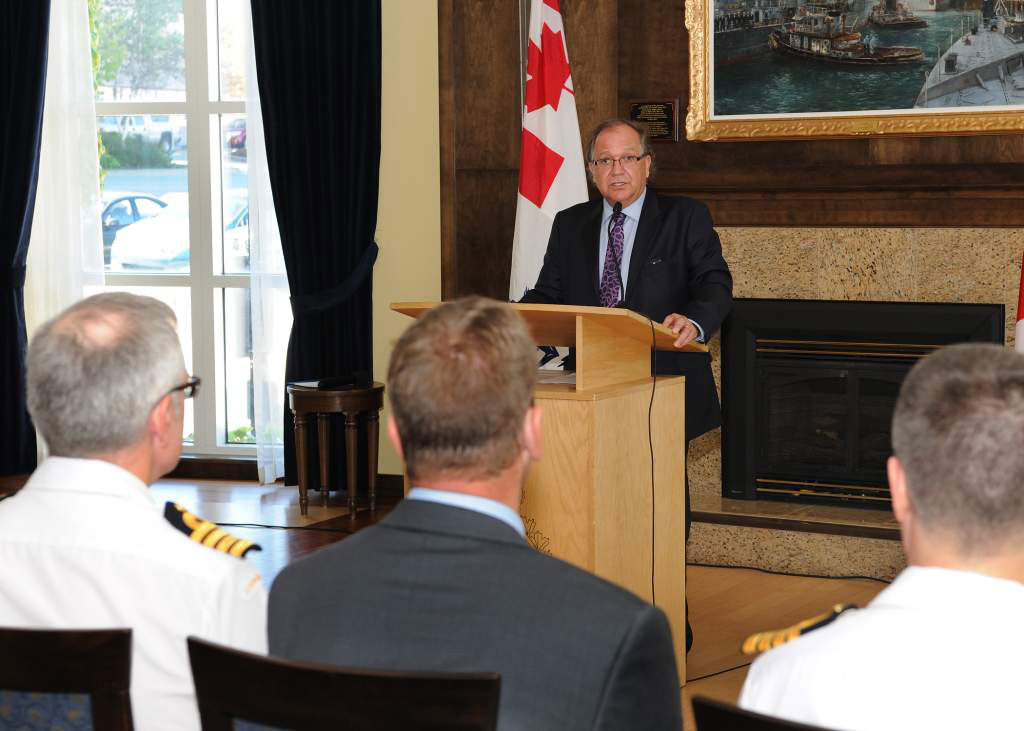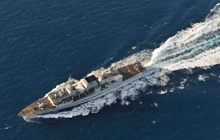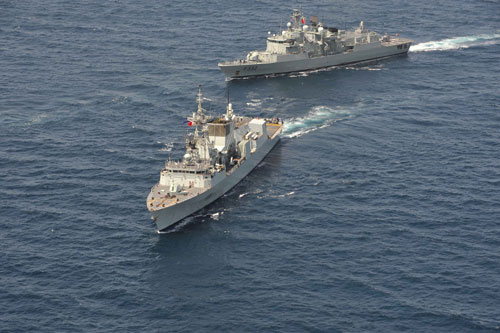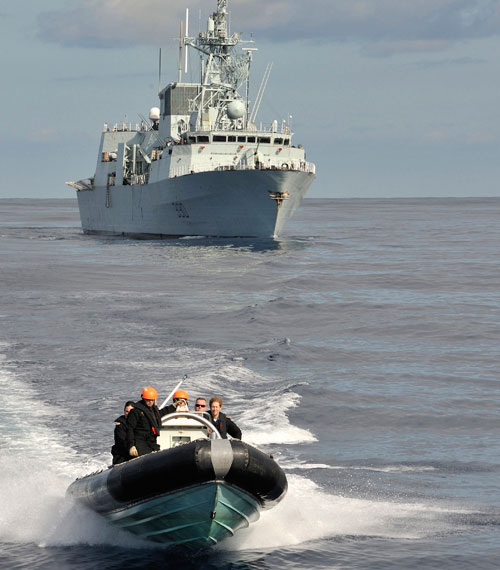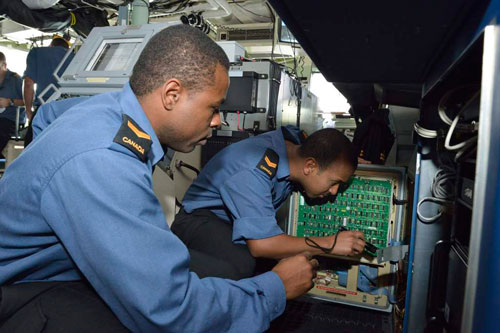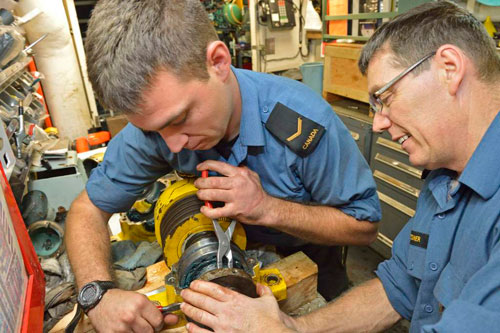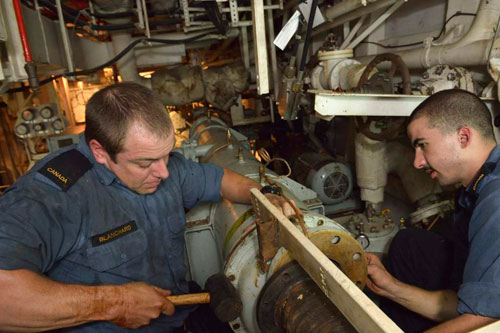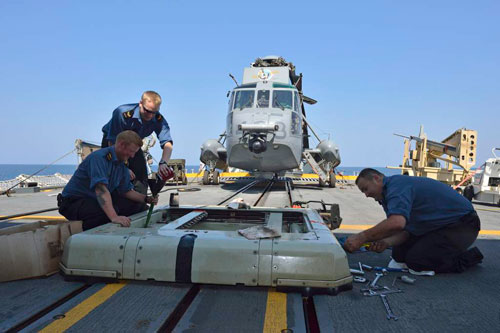Halifax-class modernization and frigate life extension
Transcript
Ever wondered what it takes to rebuild a warship? Find out with this Royal Canadian Navy (RCN) documentary on the Halifax Class Modernization/Frigate Life Extension project. It reveals the scope and detail of this multi-billion dollar project.
In the documentary, RCN sailors explain why the frigates needed upgrading, the complexity of the task, and the meticulously planned and executed engineering challenges. An RCN commodore and three commanding officers walk through the process, from the fine details to the big picture.
Various specialists discuss some of the daunting details that must be completed correctly if the project is to succeed. In addition to fresh and exclusive behind-the-scenes footage and cutting-edge, time-lapse sequences, the show harkens back through RCN film archives to show two of the ships being launched in the early 1990s, and one of the current commanding officers as a young lieutenant, interviewed on the bridge wing of HMCS Vancouver during its maiden re-positioning voyage from Halifax to Victoria more than two decades ago.
The 12 Canadian-built multi-role patrol frigates are considered the backbone of the RCN and can deploy anywhere in the world – with NATO or with individual allied nations.
Project summary
The Royal Canadian Navy’s 12 Canadian-built Halifax-class multi-role patrol frigates have reached the middle of their life and are undergoing a refit. The Halifax-Class Modernization program is on-budget and currently expected to cost $4.3 billion.
The ships are the backbone of the Navy. They can deploy anywhere in the world, either independently or with NATO or individual allied nations. Commissioned between 1992 and 1996, they are receiving state-of-the-art upgrades that include a new Combat Management System, new radar capability, new electronic warfare systems and upgraded communications and missile systems.
The modernized Halifax-class frigates will serve as a bridge to the future fleet and, along with Kingston-class Maritime Coastal Defence Vessels and Victoria-class submarines, will allow the Navy to continue to deliver on its core mission until the arrival of the Canadian Surface Combatants.
Project phases

Currently in Phase 5: Close-out
1. Identification
1. Identification
- Not available
2. Options analysis
2. Options analysis
- Not available
3. Definition
3. Definition
- Project Approval Definition February 21, 2005
4. Implementation
4. Implementation
- Request for proposal for multi-ships contract (i.e. with the two shipyards): July 6, 2007
- Request for proposal for multi-ships contract close: August 17, 2007
- Request for proposal for combat system integration design and build: February 21, 2008
- Request for proposal for combat system integration design and build close: June 9, 2008
- Project approval implementation: September 4, 2008
- Contract award: November 7, 2008
- First delivery: June 15, 2012
- Initial operational capability: February 17, 2015
- Final delivery: November 30, 2016
- Full operational capability: January 31, 2018
5. Close-out
5. Close-out
- Learn more about the Defence procurement process
Image gallery
Latest News
Additional information
Project updates
Project updates
March 2024
Effective Project Closeout (EPC) was declared in January 2019 with Final Project Closeout (FPC) expected in summer 2026. FPC is linked to completion of the fifteen remaining engineering changes and contract closeout activities.
December 2017
HMCS Toronto completed acceptance trials.
July 2017
HMCS Ville de Québec completed acceptance trials.
November 2016
HMCS Toronto is the seventh and final frigate on the East coast to complete its modernization by Irving Shipbuilding Inc.
August 2016
Nine of the Royal Canadian Navy’s 12 frigates have been returned to the Navy and are now ready to deploy on operations and exercises around the world. Two frigates are in their reactivation phase and one frigate is in refit. From late 2014 to early 2016, two of the Navy’s recently modernized frigates, HMCS Fredericton and HMCS Winnipeg, were successfully deployed on Operation REASSURANCE.
April 2016
HMCS Regina was returned to the Navy to complete sea trials and for use in future operations and exercises around the world, marking a major milestone. It is the fifth and final frigate on the west coast to complete its modernization by Seaspan’s Victoria Shipyard Co. Ltd.
March 16 2016
HMCS Vancouver marked the first ever missile test against shore-based targets.
February 2016
HMCS Fredericton deployed to the Aegean Sea as part of Standing NATO Maritime Group Task Force.
August 2015
First Article Acceptance was declared. This is formal recognition that Lockheed Martin Canada’s combat system design meets the RCN’s performance requirements.
2015
Three modernized frigates participated in the following exercises:
- HMCS Winnipeg participatedin joint NATO training exercises that included Exercise NORTHERN COAST 2015 (September), and Exercise JOINT WARRIOR (October);
- HMCS Winnipeg and HMCS Halifax participated in Exercise TRIDENT JUNCTURE 15 (October to November);
- HMCS Montréal participated in a multinational exercise known as “At Sea Demonstration” (ASD) 2015 led by the Maritime Theater Missile Defence Forum (October).
January to March 2015
The first CH-148 (Cyclone) sea trials are completed by a military crew on a modernized Ship (HMCS Halifax).
Late 2014
The first modernized frigate re-entered service.
More updates for the Halifax-class modernization and frigate life extension project.
December 2014
HMCS Fredericton, the first modernized ship, deployed in an operational theatre using new capabilities.
November 2014
HMCS Fredericton conducted a force generation missile exercise.
June 2014
The first successful evolved sea sparrow missile firing test took place.
Benefiting Canadian industry
Benefiting Canadian industry
Industrial and Regional Benefits
For the refit program, two competitive multi-ship contracts (MSC) have been awarded to Irving Shipbuilding Inc. on the East coast and Seaspan's Victoria Shipyards Co Ltd. on the West coast. Lockheed Martin Canada was also competitively sourced for the Combat System Integration (CSI).
Industrial Regional Benefits obligations are as follows:
- Combat System Integration: $1.601 billion completed of $1.572 billion as of May 2018. Lockheed Martin Canada and ISED negotiated new obligations in October 2017 and will be amending the contract.
- Shipyards (East): $0.185 billion completed as of May 2018 on $0.688 billion, an additional $0.363 billion are in progress
Shipyards (West): $0.505B Industrial Regional Benefits Obligations; $0.422 billion completed of $0.505 billion as of May 2018 with $0.083 billion to be identifiedFor more information, visit the Innovation, Science and Economic Development Canada website:
- Halifax Class Ship Modernization—Sirius Radars
- Halifax Class Ship Modernization—Shield Countermeasures
- Halifax Class Ship Modernization — Integrated Platform Management System
- Halifax Class Ship Modernization—Shipyard West
- Halifax Class Ship Modernization—Shipyard East
- Halifax Class Ship Modernization—Combat Systems Maintenance
- Halifax Class Ship Modernization—Combat Systems Integrator
- Halifax Class Ship Modernization—57 mm Gun
In addition, based on the management and success of the program, it has become a partnership model for future shipbuilding projects and has been recognized internationally. The Department of National Defence (DND) assisted the New Zealand Ministry of Defence with their decision to upgrade the combat systems on their ANZAC-class ships. DND provided valuable information to New Zealand on the Combat Management System, installed as part the Halifax-Class Modernization and Frigate Life Extension project, and shared our modernization experiences.
Contractors
Some of the links below lead to websites that are not part of the Government of Canada and may be available in English only.
The Halifax-Class Modernization program is a highly complex and collaborative effort between the Government of Canada and more than 30 companies within the Canadian defence industry. Together, they are delivering a first-class capability, on-time and on-budget while also ensuring robust economic benefits to Canada. Some of the prime companies involved in this program are:
- Lockheed Martin Canada (Combat Management System).
- Irving Shipbuilding Inc.’s Halifax Shipyard (upgrade work on east coast).
- Seaspan’s Victoria Shipyards Co Ltd. (upgrade work on west coast).
Technical information
Technical information
The project includes the modernization and refitting of the fleet with state-of-the-art upgrades such as:
- a new Combat Management System
- a new radar suite
- an internal communications system upgrade
- a harpoon missile system upgrade (surface-to-surface)
- a multi-link system
- new electronic warfare systems
- modifications to the 57 mm naval gun
- enhanced capability to employ the Evolved Sea Sparrow Missile (surface-to-air)
- a new Integrated Platform Management System offering better damage control
- modern electronic and machinery control
- other preventive, corrective and mid-life maintenance activities
Specifications:
- Length: 134 metres
- Width: 16 metres
- Weight: 4,770 tonnes
- Crew size: 225 personnel
More information on the Halifax-class Canadian Patrol Frigate
Project costs
Project costs
The Halifax-Class Modernization program is on-budget and currently expected to cost $4.3 billion. The costs include $2,758 million for acquisition and $3,528 million for in-service support.
